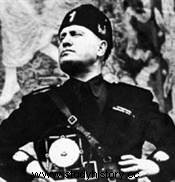 Benito Mussolini was an Italian politician and dictator, founder and leader of the Fascist Party . In 1922, he organized the famous march of the blackshirts on Rome, where the king charged him with forming a government. Having obtained full powers from parliament, he set up an authoritarian regime and took the title of "Duce ". Skilfully wielding propaganda, Mussolini transformed Italy into a totalitarian state which intervened in all sectors of society. He belatedly joined Hitler and the Nazis in the Second World War, a conflict in which he proved to be a poor military leader and was executed by Iatlian resistance fighters on April 28, 1945.
Benito Mussolini was an Italian politician and dictator, founder and leader of the Fascist Party . In 1922, he organized the famous march of the blackshirts on Rome, where the king charged him with forming a government. Having obtained full powers from parliament, he set up an authoritarian regime and took the title of "Duce ". Skilfully wielding propaganda, Mussolini transformed Italy into a totalitarian state which intervened in all sectors of society. He belatedly joined Hitler and the Nazis in the Second World War, a conflict in which he proved to be a poor military leader and was executed by Iatlian resistance fighters on April 28, 1945.
Benito Mussolini, of the socialist militant
Benito Mussolini was born on July 29, 1883, in a small town in Romagna. His father, craftsman and convinced socialist gave him the first name of the Mexican revolutionary Benito Juarez. The young Benito was quickly noticed for his violent inclinations, which did not prevent him from starting a career as a teacher. A radical socialist activist, his opinions earned him the suspicion of the Italian authorities. He ended up fleeing his country for Switzerland in order to escape military service.
In exile, Benito Mussolini became one of the figures of the Italian Socialist Party (PSI) and a recognized political journalist. Returning to Italy, his rise was rapid and in 1911, after his campaign against the Libyan war, he was considered the leader of the maximalist (revolutionary) wing of the PSI. Renowned for his virulent articles, the one who first denounced the imperialist war (that of 1914), then committed himself to rallying Italy to the Triple Entente. Expelled from the PSI because of his interventionism, he founded his own newspaper Il Popolo d'Italia then goes to fight on the front of the Alps.
...to the fascist dictator
On his return from the front, Mussolini took note of the danger of a possible Bolshevik revolution in Italy. Abandoning his old socialist convictions, in 1919 he created the “Italian Combat Beams”, which amalgamated revolutionary trade unionists and nationalists disappointed by Italy’s territorial gains. Posing as a recourse against communist agitation, supported by industrialists, Mussolini and his fascists spread terror against their Marxist opponents. In an Italy upset by the provisions of the Treaty of Versailles concerning it, the propaganda of the fascists finds a growing echo among the population of the peninsula.
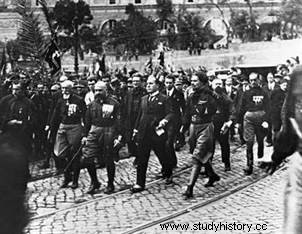 After a series of intimidations and violent attacks, Mussolini "Duce" (Leader) of the PNF (Parti National Fascist, established in 1921) seizes power. With the agreement of King Victor Emmanuel III, he became President of the Italian Council on October 28, 1922 following the march on Rome. In the years that followed, and especially from 1925, the Duce worked to make Italy a totalitarian state, guided by the precepts of Fascist ideology. His ultimate goal besides creating a society of new men and raising his country to the status of a great power, by force if necessary. To achieve this ambition, he ensured at least the neutrality of the pope by signing the Lateran Accords of February 1929 with the Vatican, which regulated the status of the Holy See and established a concordat in Italy.
After a series of intimidations and violent attacks, Mussolini "Duce" (Leader) of the PNF (Parti National Fascist, established in 1921) seizes power. With the agreement of King Victor Emmanuel III, he became President of the Italian Council on October 28, 1922 following the march on Rome. In the years that followed, and especially from 1925, the Duce worked to make Italy a totalitarian state, guided by the precepts of Fascist ideology. His ultimate goal besides creating a society of new men and raising his country to the status of a great power, by force if necessary. To achieve this ambition, he ensured at least the neutrality of the pope by signing the Lateran Accords of February 1929 with the Vatican, which regulated the status of the Holy See and established a concordat in Italy.
Fascist Italy put to the test of war
This will, combined with the effects of the 1929 crisis, will push him to a bellicose foreign policy, with in particular the invasion of Ethiopia in 1935-1936, then the support for Franco in the Spanish Civil War. After having participated in the Munich agreements, he ended up rallying, after initial reluctance, to Hitler's Germany and committed his country on June 10, 1940 to war against the allies. Fascist Italy, badly managed, badly prepared for a total industrial war will know a long series of defeats, which will culminate in the fall of Fascism in July 1943.
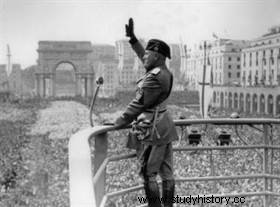 The year 1943 opened with bleak prospects for the Duce and his regime. Italy, engaged in the war alongside Germany since June 1940, quickly demonstrated the extent of its unpreparedness for an industrial and modern conflict. In Greece the Italians only owe their success to the massive help of the Germans, Italian East Africa (Somalia, Eritrea and Ethiopia) could not be defended beyond the year 41 and the campaign of North Africa, despite the support of a Germanic expeditionary force finally ended in a long retreat towards Tunisia.
The year 1943 opened with bleak prospects for the Duce and his regime. Italy, engaged in the war alongside Germany since June 1940, quickly demonstrated the extent of its unpreparedness for an industrial and modern conflict. In Greece the Italians only owe their success to the massive help of the Germans, Italian East Africa (Somalia, Eritrea and Ethiopia) could not be defended beyond the year 41 and the campaign of North Africa, despite the support of a Germanic expeditionary force finally ended in a long retreat towards Tunisia.
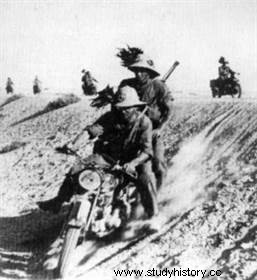 The Italian Fleet (Regia Marina) so feared before the war, proved incapable of facing up to the Royal Navy and saw its corps decapitated after the Taranto carrier raid (November 1940). Mussolini who thought of engaging in the summer of 1940 in a war parallel to that of the Third Reich, was finally forced to play the supporting roles. He who once inspired Hitler is now his debtor, the Italian war effort cannot continue without the support of Berlin.
The Italian Fleet (Regia Marina) so feared before the war, proved incapable of facing up to the Royal Navy and saw its corps decapitated after the Taranto carrier raid (November 1940). Mussolini who thought of engaging in the summer of 1940 in a war parallel to that of the Third Reich, was finally forced to play the supporting roles. He who once inspired Hitler is now his debtor, the Italian war effort cannot continue without the support of Berlin.
For the Duce this situation is more than a humiliation, a terrible disappointment. Contrary to his hopes, the war did not give birth to the new Italian, rid of the vices of bourgeois and materialistic society. The Italian people are not enthusiastic about this war (even if their soldiers fight bravely when they are well commanded) and bear the full brunt of the restrictions, such as the effects of the bombardments. The resulting discontent is now expressed publicly, as during the great strikes of February 1943.
The fear of the return of labor unrest and doubts about the ideological orientations of Fascism (in particular the alignment with a weakened Germany and the racial policy that results from it) do little the crumbling of the cement of the regime:the alliance between the conservative elites and the PNF (National Fascist Party). Soon the protesters put their hopes on their traditional recourse, namely the King.
The Conservative Plot
While secretly probing the allies, regime caciques such as Ciano (Minister of Foreign Affairs and son-in-law of the Duce) or Marshal Badoglio are seriously considering overthrowing Mussolini. The surrender of the German-Italian armies in Tunisia in May 1943 convinced them of the urgency of the situation. Indeed, contrary to Duce's public statements, it is now clear that Italy itself is threatened by an Allied landing.
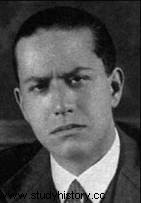 This one happens on July 10 (Operation Husky). 160,000 men of the VIIth American army (Patton) and VIIIth British army (Montgomery), quickly set foot on either side of Cape Passero. Despite difficult atmospheric conditions and the vagaries of airborne operations, they managed to shake up the defense of Guzzoni's VI Italian Army, which was nevertheless supported by elite German units (Paratroopers, armored division Hermann Goering, etc.). On 16 Churchill and Roosevelt, jointly call on the Italians to overthrow the Fascist regime. While in Sicily the population (and the mafia) prove to be of great help to the allies, on the continent the resentment against Fascism is expressed in the streets.
This one happens on July 10 (Operation Husky). 160,000 men of the VIIth American army (Patton) and VIIIth British army (Montgomery), quickly set foot on either side of Cape Passero. Despite difficult atmospheric conditions and the vagaries of airborne operations, they managed to shake up the defense of Guzzoni's VI Italian Army, which was nevertheless supported by elite German units (Paratroopers, armored division Hermann Goering, etc.). On 16 Churchill and Roosevelt, jointly call on the Italians to overthrow the Fascist regime. While in Sicily the population (and the mafia) prove to be of great help to the allies, on the continent the resentment against Fascism is expressed in the streets.
Mussolini, who met Hitler on the 19th (interview with Feltre) believed he was assured of Berlin's support and thought he could rely on supporters of a hard Fascist line (like Scorza ) to stay in power. Nevertheless, weakened by illness and psychologically fragile, he is no longer able to perceive the extent of his son-in-law's schemes. The latter with the help of his allies, obtained from the King to overthrow the Duce by a constitutional coup by taking advantage of a meeting of the Grand Fascist Council scheduled for the 24th. The anger of the Roman crowd after an Allied bombardment, carried away the last hesitations of Victor Emmanuel III.
The fall of Mussolini
The Council opens in an atmosphere made detestable by rumors of a putsch. Mussolini, however, alerted to the plot that is brewing against him, prefers not to risk the showdown. The two-hour speech he gave that day no longer has the force of the long diatribes of yesteryear. When Galeazzo Ciano and Grandi respond the attack is all the more violent. Accused of having betrayed his country and having dragged it alongside Germany (the enemy of the previous war, let us remember) in a hopeless war, Mussolini was stunned. By nineteen votes to seven the motion of his opponents won, after a vote around 2 a.m. on July 25. The King now has in his hands the legal instrument that will allow him to dismiss the man who has been his Prime Minister for 21 years...
July 25, 1943. This is a Benito Mussolini nervous who responds to the summons of the King of Italy Victor Emmanuel III by going to the Villa Savoia. The meeting of the Grand Fascist Council the day before initiated what the Duce himself called a "crisis of the regime." Nevertheless, the master of the destinies of Italy since 1922, still thinks he can turn the situation to his advantage. What is his surprise, when the King in full uniform (while he has ordered the dictator to wear a civilian costume) announces to him that he has been dismissed, replaced as Prime Minister by Marshal Badoglio. After barely twenty minutes of interview, Mussolini was fired and then arrested by carabinieri. The Fascist regime has just been overthrown, without a shot...
At the head of a puppet state in a divided Italy
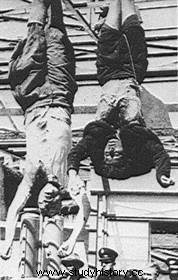 Mussolini's fall was to have significant consequences for the course of World War II. Indeed it paved the way for sustained negotiations by the Badoglio government with the allies so that when the time came to leave the German alliance. This will be done on September 8, 1943, when the Anglo-Saxons land in the south of the peninsula. Hitler, forced to invest heavily in Italy to defend his southern flank, thus decided to suspend the participation of the SS armored corps in Operation Citadel in Kursk.
Mussolini's fall was to have significant consequences for the course of World War II. Indeed it paved the way for sustained negotiations by the Badoglio government with the allies so that when the time came to leave the German alliance. This will be done on September 8, 1943, when the Anglo-Saxons land in the south of the peninsula. Hitler, forced to invest heavily in Italy to defend his southern flank, thus decided to suspend the participation of the SS armored corps in Operation Citadel in Kursk.
For Italy, with the liberation of Mussolini by a German commando on September 12, it was the start of a civil war lasting a year and a half that was to ravage the north of the country. The creation of the Italian Social Republic (known as the Salo regime) will be an opportunity for the hardline Fascists to carry out their totalitarian program, without monarchical or conservative interference. As for the Duce, undermined by illness, he knew in advance that the game ended for him in Mezzegra on April 28, 1945. Benito Mussolini and his mistress Clara Petacci were shot there by Italian partisans after being captured. Their remains will then be exhibited in Milan, hung upside down from a balustrade to be shouted at by the crowd. Thus ended the destiny of a man who had dreamed of himself as the omnipotent guide of a new Roman empire.
Bibliography
• Pierre Milza, Mussolini, Fayard, 1999
• Mussolini. A Dictator at War, by Max Schiavon. Perrin, 2016.
• Didier Musiedlak, Mussolini, Presses de Sciences Po, 2004, 436 pages.
To go further
- Hitler - Mussolini - Stalin, documentary by H. Kasten Ullrich. Arte Video, 2010.
